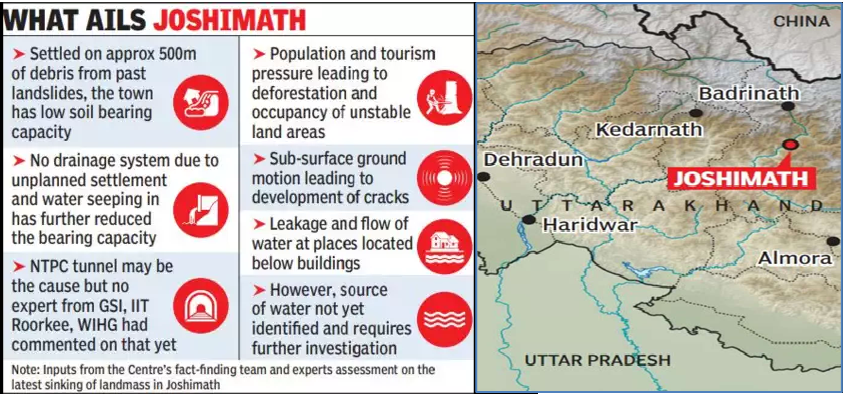- Home
- Prelims
- Mains
- Current Affairs
- Study Materials
- Test Series
Land Subsidence in Joshimath
Residents of Joshimath, a town in Uttarakhand, have been forced to leave their homes due to cracks that have appeared in the structures and the roads. The district has been declared a disaster zone by officials, with over 600 houses affected by land subsidence, a phenomenon that occurs when the earth gradually sinks.
Joshimath
- Joshimath is a town located in the Chamoli district of Uttarakhand, India. It is situated at an altitude of 6,200 feet above sea level, in the lower Himalayas. Joshimath is a popular tourist destination, known for its beautiful surroundings and as a gateway to several popular hill stations and religious sites in the region.
- Joshimath has a subtropical highland climate, with cool winters and mild summers. The town is surrounded by dense forests and has a rich flora and fauna. The Nanda Devi National Park, a UNESCO World Heritage Site, is located nearby.
- Joshimath is an important center for Hindu pilgrimage, with several temples and ashrams located in the town. The most famous temple is the Sri Badrinath Temple, dedicated to the Hindu god Vishnu. The town is also home to a number of educational institutions, including a college and several schools.
- Joshimath is connected to the rest of the state by road and is also served by a small airport. The town has a number of hotels, guest houses, and other accommodation options for tourists.
Issues faced by the people of Joshimath
- Land instability: Hilly terrain is often prone to landslides, erosion, and other forms of land instability, which can pose a risk to buildings and infrastructure in the area.
- Limited resources: High-altitude settlements like Joshimath may face challenges related to access to resources such as water, electricity, and healthcare, as the terrain can make it difficult to build and maintain infrastructure.
- Economic challenges: Hilly settlements may face economic challenges due to their remote location and limited opportunities for industry and commerce.
- Environmental challenges: The fragile ecosystem of hilly regions can be threatened by development and other human activities, leading to issues such as deforestation, pollution, and habitat loss.
Land subsidence or sinking
Land subsidence refers to the sinking or settling of the ground surface. It can occur when the ground beneath the surface collapses or compacts, causing the surface to sink. Land subsidence can be caused by a variety of factors, including:
- Extraction of underground resources: The removal of oil, natural gas, or other underground resources can cause the ground to sink as the empty space left behind collapses.
- Consolidation of soil: Soil can consolidate or compress over time, especially if it is saturated with water or subject to heavy loads. This can cause the ground surface to sink.
- Erosion: Erosion can weaken the ground and make it more prone to subsidence.
- Aquifer depletion: If water is pumped from an underground aquifer faster than it can be replenished, the ground above the aquifer can sink as the water level drops.
- Faulting and landslides: Faulting and landslides can also cause land subsidence, as the ground can shift or collapse when geological forces are at work.
Land subsidence can have serious consequences, including damage to buildings and infrastructure, flooding, and other hazards. It is important to carefully monitor and manage land use in areas where subsidence is a risk.

Solutions
There are several strategies that can be implemented to prevent or mitigate land sinking in hilly settlements such as Joshimath:
- Stabilizing slopes: One effective way to prevent landslides and erosion is to stabilize slopes using techniques such as terracing or installing retaining walls.
- Planting vegetation: Planting vegetation on slopes can help to anchor the soil and prevent erosion. Trees and other deep-rooted plants are particularly effective at stabilizing slopes.
- Drainage control: Poor drainage can contribute to land sinking, so it is important to properly manage and maintain drainage systems in hilly settlements. This may involve installing culverts or other drainage structures to channel water away from slopes and prevent erosion.
- Strengthening foundations: In some cases, it may be necessary to strengthen the foundations of buildings in hilly settlements to prevent them from sliding or collapsing. This could involve underpinning or adding reinforcement to the foundations.
- Planning and zoning: Careful planning and zoning can help to prevent the construction of buildings in areas that are prone to landslides or erosion. This may involve designating certain areas as no-build zones or requiring the use of special construction techniques in high-risk areas.
Land subsidence is a critical issue that needs to be addressed urgently. The government and other organizations must take action to help the affected families and to prevent further incidents of land subsidence from occurring. It''s important to take a multi-disciplinary approach that involves identifying the causes of the land subsidence, and developing and implementing mitigation strategies in order to protect lives and properties in the long term. To save Joshimath, the government and civil bodies must work together, with the assistance of military organisations such as the Border Roads Organisation (BRO).









 Latest News
Latest News
 General Studies
General Studies